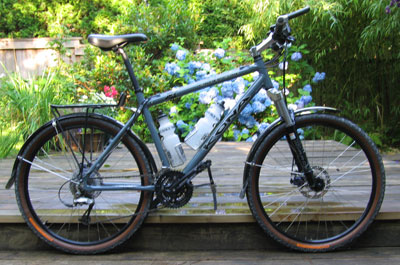
« The route :: The 3 Ps: Preliminaries, Preparations and Packing »
July 14, 2004

Since much of the route will be on walking trails, rather than paved roads, I will be riding a mountain bike rather than a standard touring bike. There’s a penalty in weight, of course: I weighed the bike this morning and it tips the scales at 16 kg without panniers. The straight front suspension forks (rather than the raked touring-bike design) gives a much shorter wheelbase than my 1980 F. W. Evans bike, or the 1987 Bauer Whistler, and the straight handlebars will result in a more upright riding style: greater wind resistance. I’ll miss the drop handlebars, but I’ve added bar-ends to provide at least a couple of different hand grip positions while riding.
The bike is more-or-less stock, from Cove Bike Shop in Deep Cove (thanks to Dave Bowes and his crew for their help in getting everything just right). It’s a 19” Kona Cinder Cone — the full specs are here for anyone interested. The only thing I changed (apart from adding the bar-ends, a rear rack, some fenders, an odometer and a bell) was the tooth-count on two of the front chainrings. Stock gearing has a range of 11-32 teeth on the rear cluster (9 gears), and a triplet of 22/32/44 on the front. That might be fine for the kind of riding the bike was designed for (trail riding, short busts of speed, lots of gear choices at the lower end). On long tours, though, you don’t need as much at the lower end. I tend to do most of my riding in the middle chainring, and I found that with the 22/32/44 combination my cruising pace straddled the middle and the top chainrings: I’d be constantly shifting between the top end of the middle chainring and the low end of the large chainring. So I had them change to a 24/34/44 combination on the front.
This is the first bike I’ve owned with disk brakes. Everybody swears by them for trail riding and wet conditions, but I have yet to be convinced. There’s the (small amount of) extra weight; the greater mechanical complexity (simplicity=good with bicycles); the difficulty in finding spare brake pads while on the road. And I find that the braking is a lot “grabbier”. I’ll give them a try, though.
The peripherals: fenders, rear rack, bell, odometer, bar-ends, rear panniers — are all from Mountain Equipment Coop in Vancouver. The tires are too: I swapped the stock (knobby) tires for the Continental Town and City tire: the tread is better suited for a mix of off-road and pavement.
I have a handlebar bag as well, one that I’ve had for a number of years, and have been pleased with. It’s from Cannondale; it looks like it might be an earlier version of what they’re now calling their Crossroads model. I particularly like the Cannondale barbag mounting system: very solid. No front bags on this trip though: I used both front and rear bags on my 1987 round-the-world bike trip, and the front bags took some getting used to. But front bags are difficult to mount to a mountain bike: the front suspension forks don’t really provide any mounting points. And I’m really trying to keep the luggage weight down on this trip (famous last words), so I’m going to go with rear panniers only (the excellent Serratus Aqua-Not). I’ll be taking a sleeping bag and mat (most people I’ve talked to say you’ll need these for the refugios), and a small tent (walking pilgrims have priority over cyclists at the refugios, and a tent will give me some flexibility at the cost of the added weight). These items will be bungeed on to the rear rack above the panniers.
I have fond memories of cycle-camping in France on my inaugural bike trip. But I’m not as young as I used to be back then. A soft bed at day’s end, and a good, hot meal sounds more appealing from this vantage point.
![]()
© 2004 Michael Hayward
« previous
::
next »
The route
The bike
The 3 Ps: Preliminaries, Preparations and Packing
Dry run
Departure! (and contact info)
Books
Beginning to begin
Toulouse
Burgos
El Burgo Ranero
Advice
Villadangos del Paramo
Rabanal del Camino
Interlude: A New Philosophy
Villafranca del Bierzo
Approaching Santiago
Santiago de Compostella
The end of the earth